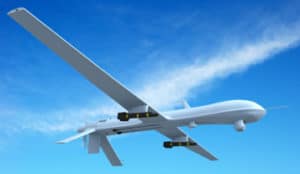The trend toward replacing pneumatic and hydraulic actuators and controls with electrical controls has placed an increasing burden on the unmanned electrical power distribution system. That means the UAV design team member who is tasked with specifying components for the power system needs to consider five factors that will affect the performance and reliability of the platform. Prioritizing each of these factors in your power distribution design is critical.
1. Efficiency and Weight
The efficiency of power converters and bus switches will affect the use of the available fuel load and thermal management in the platform. This is true whether the unmanned uses MIL-STD-704 400 Hz AC power, a high-voltage DC bus, or a low-voltage DC bus. Ultimately, waste heat energy derived from fuel must be disposed of, but it can be highly problematic to do so in a high-altitude UAV where avionics are often located in pressurized compartments and composite construction makes heat transfer extremely challenging.
Reduction of the system heat load will reduce the weight of the cooling system and extend the range and payload capacity of the aircraft thereby increasing overall efficiency. Therefore, liquid cooling using fuel or PAO is sometimes used in these vehicles.
Furthermore, designing power converters or TRUs for minimum size and weight (while meeting specific system requirements) will result in more efficient use of fuel and available payload capacity. Advanced thermal design techniques, a lightweight case, potting and connector materials, and more recent semiconductor technologies such as SiC are typically used to achieve the appropriate balance between weight and efficiency.
2. Quality
As size and weight of power conversion or control equipment goes down, maintaining reliability becomes a growing concern. It’s essential that you choose an AS9100C certified manufacturer to ensure the manufacturing processes are being carefully controlled and monitored. The system designer must work closely with the component manufacturer, so all aspects of the design are carefully analyzed and components are selected to work reliably in the anticipated application of the system.
3. Built-in Test and Control Functions
Adding test, control, and monitoring functions to an existing system using COTS converters could be costly and will undoubtedly waste space and weight. Therefore, the system designer must determine the needs for specific control and monitoring functions as early in the design process as possible.
As UAV missions become more complex, the demand for accurate, real-time system information continues to increase. For example, you’ll need to test, control, and monitor power converters to include output voltage and current, temperature and input, engagement or battleshort of protective features, and the enable/disable sequencing of converters. The increasing demand for test, control, and monitoring functions will continue to grow in the future, so you must prioritize them early in your power system design process.
4. Flexibility
In order to save time and money in the future, work with a supplier that is both able and prepared to modify its standard product in a timely manner to meet all of your specific system requirements without excessive non-recurring charges. Flexibility is critical to the UAV design over the long-term. Designing a flexible power distribution system will not only help you to minimize fuel waste in the future, but it will enable the system to easily grow with your evolving requirements.
5. Cost of the Components
Choose reliable but flexible components so you don’t incur large expenses in the future when you need to modify your UAV power distribution system. Furthermore, design a system that maximizes efficiency so you can control costs while reducing fuel waste. A flexible and balanced system designed today with high quality components will save you money and reduce problems over the long-term.
To learn more about choosing components for your UAV power system, contact Abbott Technologies today at (818) 504-0644 or visit us at www.abbott-tech.com.


